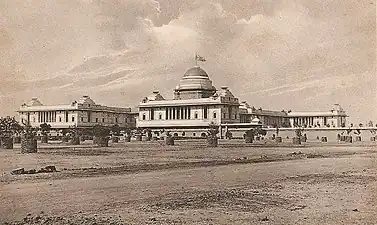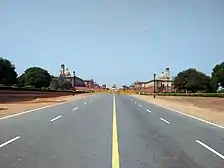Raisina Hill
Raisina Hill (IAST: Rāysīnā Pahāṛī), often used as a metonym for the seat of the Government of India, is an area of New Delhi, housing India's most important government buildings, including Rashtrapati Bhavan,[1][2] the official residence of the president of India on a citadel at Raisina Hill and the Secretariat building housing the Prime Minister's Office and several other important ministries. The hill is seen as an Indian acropolis with Rashtrapati Bhavan as the Parthenon.
Raisina
IAST: Rāysīnā Kī Pahāṛī | |
|---|---|
 Vijay Chowk with North and South Block in the backdrop. As one looks at the Raisina Hill buildings from Vijay Chowk, the Rashtrapati Bhavan disappears and only its dome is visible. | |
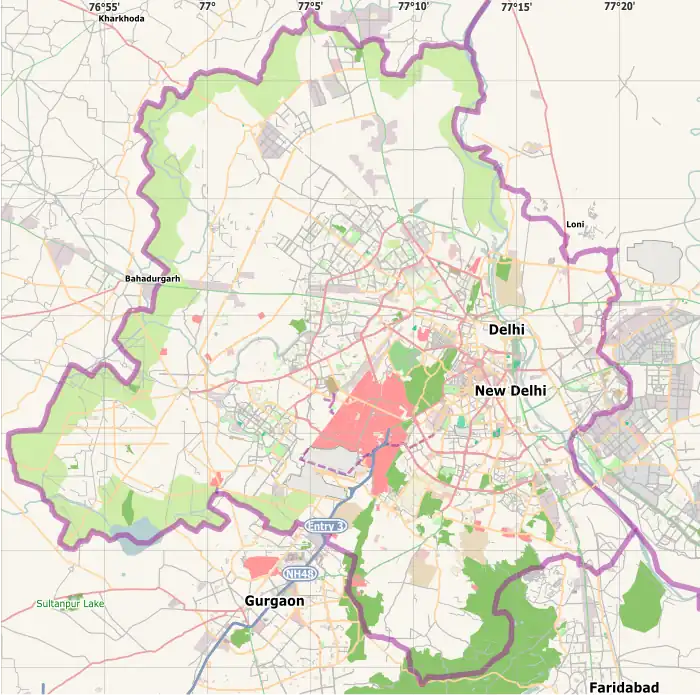 Raisina Location in Delhi, India | |
| Coordinates: 28.614°N 77.205°E | |
| Country | |
| Union Territory | Delhi |
| Districts | New Delhi |
| Time zone | UTC+5:30 (IST) |
Under the Central Vista project, the Prime Minister’s residence will be shifted behind the existing South Block, while the V-P’s residence is proposed to be relocated behind North Block. The Vice President's enclave will be on a site of 15 acres, with 32 five-storey buildings at a maximum height of 15 meters. The Prime Minister's new office and residence will be on a site of 15 acres, with 10 four-storey buildings at a maximum height of 12 meters with a building for keeping Special Protection Group.[3] The project also includes converting North and South Blocks into public museums, creating an ensemble of new secretariat buildings to house all ministries.
As a geographic feature, The "Raisina hill" is a slightly elevated portion 266 m (873 ft) high, about 18 m (59 ft) higher than the surrounding area and is located in a well-drained area between the Delhi Ridge and the Yamuna River with good drainage facility too.
The Raisina Hill is open to the public and offers individual and group guided tours. The Raisina Hill buildings continue to attract thousands of visitors from across the world for the sense of grandeur they project.
History of Raisina Hill
During the colonial era, leading British architects Edwin Lutyens and Herbert Baker envisaged the Central Vista complex as the centre of administration in India to house all facilities needed for efficient functioning of the Government. It was inaugurated in 1931 and consisted of the buildings Rashtrapati Bhawan, Parliament House, North and South Blocks and the Record Office (later named as The National Archives), along with the India Gate monument and the civic gardens on either side of the Rajpath. The plan was designed using traditional urban planning instruments, featuring a strong axis, an emphasised focal point, formation of important nodes, and a definitive termination point. At the time, it was one of the largest projects of its kind in the world, conceived and designed to reflect the spirit, progress and global importance of India.
Indian influences marked the overall design of the Raisina Hill (Central Vista). It used red and beige sandstone, which had been used for the monumental architecture of Delhi since the 13th century; the modelling of the dome of Viceroy’s House on the Great Stupa at Sanchi; ancient Indian bell capitals for the Pillars of Dominion placed between the Secretariat Blocks; and countless features of Indian architecture – jalis (pierced stone screens), chhajas (projecting overhangs), chhatris (pillared cupolas), and more.
Land Acquisition
The term "Raisina Hill" was coined following acquisition of land from 300 families from local villages was acquired under the "1894 Land Acquisition Act" to begin the construction of the Viceroy's House.
Gallery
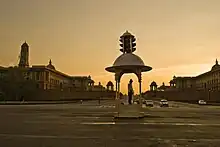 Vijay Chowk at Kartavya Path, with Secretariat Building in the background, New Delhi, the venue of the Beating Retreat ceremony
Vijay Chowk at Kartavya Path, with Secretariat Building in the background, New Delhi, the venue of the Beating Retreat ceremony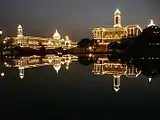 North and South Block of the Secretariat Building illuminated
North and South Block of the Secretariat Building illuminated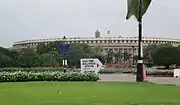 Old Sansad Bhavan - Old Parliament Building, NewDelhi as seen from the Kartavya Path
Old Sansad Bhavan - Old Parliament Building, NewDelhi as seen from the Kartavya Path North Block of the Secretariat Building seen from Kartavya Path
North Block of the Secretariat Building seen from Kartavya Path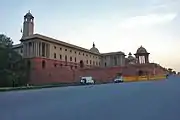 South Block of the Secretariat Building seen from Kartavya Path
South Block of the Secretariat Building seen from Kartavya Path_01.jpg.webp) Rashtrapati Bhavan seen from Kartavya Path
Rashtrapati Bhavan seen from Kartavya Path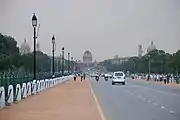 Panoramic view of Kartavya Path
Panoramic view of Kartavya Path Indian Naval contingent marching on the Kartavya Path during Delhi Republic Day parade
Indian Naval contingent marching on the Kartavya Path during Delhi Republic Day parade.jpg.webp) A band performance at India's Beat Retreat ceremony at Vijay Chowk in 2018.
A band performance at India's Beat Retreat ceremony at Vijay Chowk in 2018.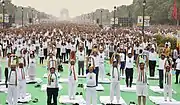 International Day of Yoga on 21 June 2018
International Day of Yoga on 21 June 2018
Delhi Metro
The nearest Delhi Metro stations to the Raisina Hill are: Central Secretariat metro station, Lok Kalyan Marg metro station, Udyog Bhawan Metro station, Janpath Metro station, Rajiv Chowk Metro station, Patel Chowk Metro station.
References
- "The might of Raisina Hill". The Indian Express. Archived from the original on 8 January 2014. Retrieved 18 July 2012.
- Goyal, Shikha (8 March 2017). "20 amazing facts about the Rashtrapati Bhavan". jagranjosh.com. Jagran Prakashan Limited. Archived from the original on 10 November 2021. Retrieved 14 July 2022.
- "Central Vista: PM residence to have 10 buildings; sources say no question of dropping proposed PMO | India News - Times of India". The Times of India. PTI. 18 December 2020. Retrieved 31 October 2022.
